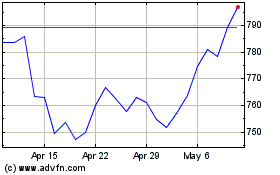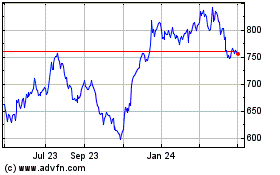By Sarah Krouse
BlackRock Inc. is presenting New York real-estate developers
with something they haven't seen in a while -- a financial firm
that is looking to grow.
While big banks and hedge funds are in retreat and emptying out
space, the asset management giant is deciding whether to move into
a new global headquarters and is narrowing its review of sites
being developed in Manhattan down to three.
The 850,000-square-foot deal will be among the biggest leases of
the year for the city and a contrast to the direction of the
banking industry. That sector's total footprint in New York City is
roughly 13 million square feet smaller now than it was in 2008,
according to real-estate brokerage firm JLL -- down about 28% since
the financial crisis and a loss equal to more than six buildings
the size of Goldman Sachs Group Inc.'s headquarters in lower
Manhattan.
"You're seeing a paradigm shift," said Scott Panzer, vice
chairman of JLL. "Where all the big financial-services firms ramped
up in the early part of the century, we've seen a huge
pullback."
BlackRock's search has become the focal point for brokers
looking to lock in one of the highest profile tenants now examining
space. The firm is considering sites at the Hudson Yards
development on the far West Side, neighboring Manhattan West and
the World Trade Center development in lower Manhattan, according to
people familiar with the matter, in addition to remaining in its
current space. The deal could be worth more than $60 million in
annual rent.
Its selection process is still under way, though a decision
could come as soon as later this year, the people said.
BlackRock, the $4.9 trillion money manager, needs more than the
700,000 square feet it currently occupies. The firm has seen its
ranks grow to about 13,000 employees globally from 5,341 employees
at the end of 2008, helped by well-timed acquisitions, regulatory
and economic shifts and evolving investor taste. Its
exchange-traded-fund business, for example, which sells low-cost
funds that track the performance of indexes, is the world's
largest.
The company, which sells mutual funds, ETFs and
investment-advisory services, is currently based on 52nd Street
between Madison Avenue and Park Avenue in New York, occupying
multiple floors in two buildings across the street from each
other.
There are few sites in the city large enough to accommodate
BlackRock, which was started from a single Midtown Manhattan office
in the late 1980s. Throughout its life, the company has filled
office space within four square blocks of the Park Avenue office in
which it was founded.
"In anticipation of our current campus lease expiring in 2023,
we are prudently planning for our long-term real-estate needs in
New York City, " a BlackRock spokesman said.
BlackRock's search comes as banks, once main drivers of
real-estate leasing activity in New York, thin out their ranks. In
addition, hedge-fund leasing activity has also slowed this year to
a fraction of last year's record activity, according to JLL. These
funds had helped fill some of the city's highest profile space in
the immediate aftermath of the financial crisis, but more recently
have shrunk as the industry grapples with uneven performance and
investor withdrawals.
In their place, traditional asset managers, foreign financial
firms, financial technology and market data companies have become
more sought after. Still, BlackRock and other asset management
firms have far smaller footprints than the million or more -- often
several million -- square feet banks fill in Manhattan.
Overall Manhattan leasing activity this year has been slow, with
the city set for its lowest year of leasing activity since 2009,
according to JLL.
Among the only banks that have agreed to fill new space in the
last 12 months is San Francisco-based Wells Fargo Securities, which
will occupy 500,000 square feet at Hudson Yards.
BlackRock and others possibly looking to move headquarters
consider more than just pricing. Companies examine what kinds of
meeting space and amenities they will require long-term and how
much of their workforce needs office space each day. Firms also
often look beyond their current locations to secure better leasing
terms at their existing space.
On price, the average asking rent for top office space at the
World Trade Center was about $75 a square foot at the end of June,
according to JLL, while the average asking rent for high-end office
space in midtown, home to Hudson Yards and Manhattan West, was
about $81 a square foot.
By those figures, BlackRock would spend between $64 million and
$69 million annually, though rents are subject to market conditions
and negotiations that take into account scale and firm-specific
requirements. BlackRock's 2015 net profit was $3.3 billion.
As part of its search, BlackRock took a preliminary look at SL
Green Realty Corp.'s One Vanderbilt, a planned skyscraper set to
rise above Grand Central Terminal, according to people familiar
with the matter, but is no longer pursuing that option.
One of the contenders the firm is considering offers office
space as well as a potential investment opportunity. Hudson Yards,
developed by Related Cos. and Oxford Properties Group, has allowed
some tenants to take a stake in the buildings they occupy.
KKR & Co. and Time Warner Inc. are among the companies that
have purchased their office space at 30 Hudson Yards. Coach Inc.,
the first tenant to move into 10 Hudson Yards, is paying $530
million for its 738,000-square-foot portion of the tower and an
additional $220 million to build out the space.
The first commercial building at the sprawling site along the
Hudson River opened earlier this year.
Brookfield Property Partners' Manhattan West project will
include office, residential and hotel space. The developer sold
part of its stake in the project to Qatar's state investment fund
late last year.
--Keiko Morris and Peter Grant contributed to this article.
Write to Sarah Krouse at sarah.krouse@wsj.com
(END) Dow Jones Newswires
July 28, 2016 02:47 ET (06:47 GMT)
Copyright (c) 2016 Dow Jones & Company, Inc.
BlackRock (NYSE:BLK)
Historical Stock Chart
From Mar 2024 to Apr 2024

BlackRock (NYSE:BLK)
Historical Stock Chart
From Apr 2023 to Apr 2024
